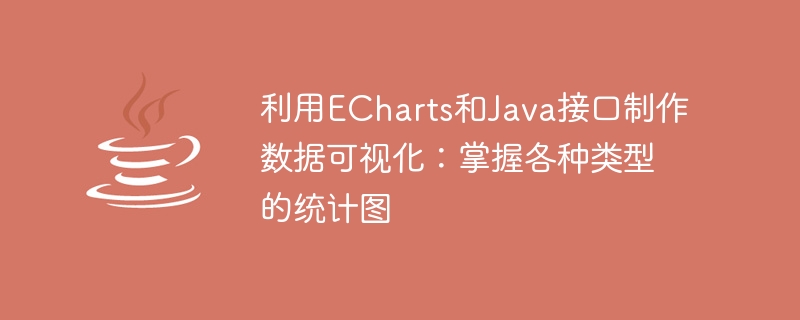

Use ECharts and Java interface to create data visualization: to master various types of statistical charts, specific code examples are required
Data visualization is a way to convert abstract data through charts A technology that visually presents data in a way that can help us better understand the patterns and trends behind the data. As an open source visualization library, ECharts provides a variety of chart types and flexible configuration options, which is very suitable for the development of data visualization. This article will introduce how to use ECharts and Java interfaces to create various types of statistical charts, and attach specific code examples.
1. Preparation work
Before using ECharts for data visualization, we need to prepare the following development environment:
2. Make a histogram
The histogram is a common statistical chart that can be used to compare data of different categories. The following is a sample code for making a histogram:
In the Java interface, we can obtain data by calling the database or other data sources, convert the data into JSON format, and then pass the JSON data to the front-end page for processing render.
@RestController
@RequestMapping("/echarts")
public class EChartsController {
@GetMapping("/bar")
public Map<String, Object> getBarData() {
Map<String, Object> data = new HashMap<>();
// 模拟数据,实际情况可以从数据库或其他数据源获取
List<String> xAxis = Arrays.asList("A", "B", "C", "D", "E");
List<Integer> seriesData = Arrays.asList(10, 20, 30, 40, 50);
data.put("xAxis", xAxis);
data.put("seriesData", seriesData);
return data;
}
}In the above code, we use the @RestController annotation to declare the class as a Restful-style controller, and use @GetMapping("/bar") The annotation specifies the method to handle the request. In this method, we simulated some data and encapsulated the data into a Map object. That Map object is then returned as the response.
3. Make a line chart
The line chart is a commonly used statistical chart, which can be used to display the trend of data changes over time or other continuous variables. The following is a sample code for making a line chart:
@RestController
@RequestMapping("/echarts")
public class EChartsController {
@GetMapping("/line")
public Map<String, Object> getLineData() {
Map<String, Object> data = new HashMap<>();
// 模拟数据,实际情况可以从数据库或其他数据源获取
List<String> xAxis = Arrays.asList("A", "B", "C", "D", "E");
List<Integer> seriesData = Arrays.asList(10, 20, 30, 40, 50);
data.put("xAxis", xAxis);
data.put("seriesData", seriesData);
return data;
}
}In this sample code, we are basically the same as the previous bar chart sample code, except that we have changed the request path and returned data.
4. Making a Pie Chart
The pie chart is a commonly used statistical chart that can be used to display the proportion of data in different categories. The following is a sample code for making a pie chart:
@RestController
@RequestMapping("/echarts")
public class EChartsController {
@GetMapping("/pie")
public List<Map<String, Object>> getPieData() {
List<Map<String, Object>> data = new ArrayList<>();
// 模拟数据,实际情况可以从数据库或其他数据源获取
Map<String, Object> item1 = new HashMap<>();
item1.put("name", "A");
item1.put("value", 10);
Map<String, Object> item2 = new HashMap<>();
item2.put("name", "B");
item2.put("value", 20);
Map<String, Object> item3 = new HashMap<>();
item3.put("name", "C");
item3.put("value", 30);
data.add(item1);
data.add(item2);
data.add(item3);
return data;
}
}In this sample code, we encapsulate each data item into a Map# by using a List object ## object, and then add all Map objects to the List object. Finally, the List object is returned as the response.
This article introduces how to use ECharts and Java interfaces to create bar charts, line charts, and pie charts, and gives specific code examples. Through these code examples, we can learn how to implement the basic process of data visualization through Java and ECharts, and how to pass data from the backend to the front-end page for rendering. I hope this article can help readers master the basic skills of data visualization using ECharts and Java interfaces.
The above is the detailed content of Use ECharts and Java interfaces to create data visualizations: master various types of statistical charts. For more information, please follow other related articles on the PHP Chinese website!
